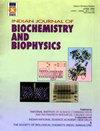Fabrication of phyco-functionalized zinc oxide nanoparticles and their in vitro evaluation against bacteria and cancer cell line
IF 1.5
4区 生物学
Q4 BIOCHEMISTRY & MOLECULAR BIOLOGY
引用次数: 0
Abstract
Macroalgae with innumerable metabolites are predominantly identified as potential organisms in industrial and pharmaceutical applications. Herein, an attempt was made to fabricate zinc oxide nanoparticles (ZnO NPs) using the aqueous extract of red macroalgae Kappaphycus alvarezii and evaluate its anti-tumor and anti-bacterial activities, in vitro. ZnO NPs was prepared via chemical reduction (C-ZnO NPs), for comparative analysis, and co-precipitation method with the extract (B-ZnO NPs). Chemical composition analyses, physical characterization by UV Spectrophotometer, Fourier Transform InfraRed (FTIR) spectroscopy, Energy Dispersive X-Ray Analysis (EDX) and Scanning Electron Microscopy (SEM) and anti-oxidant ability by DPPH assay were performed. Anti-microbial activity of the fabricated nanomaterials was performed against E. coli, Bacillus subtilis and Staphylococcus aureus. Cell toxicity study was carried out using MTT assay upon 3T3 and MCF-7 cell lines. The study resulted that the presence of phenolic content in the algal extract enhanced the biological activities of ZnO NPs at an optimized concentration of 100 mM. Total phenolic content was exa mined to be 83.73 mg gallic acid eq/g and the maximum efficiency of DPPH scavenging was revealed by the concentration of 51.99 mg/mL. Anti-bacterial effect of B-ZnO NPs demonstrated maximum efficiency at the concentrations of 800 µg/mL, 400 µg/mL and 600 µg/mL against Escherichia coli, Bacillus subtilis and Staphylococcus aureus respectively. The cell viability study denoted that the fabricated B-ZnO NPs were non-toxic towards 3T3 while significant cytotoxicity was observed against MCF-7 at an IC50 of 75 µg/mL at 48 h. In conclusion, the B-ZnO NPs was observed to be effective as both bactericidal and anti-cancerous nano-agent and considered further for pharmaceutical applications.植物功能化氧化锌纳米颗粒的制备及其对细菌和癌细胞的体外活性评价
具有无数代谢物的大型藻类主要被认为是工业和制药应用的潜在生物。本研究以红藻Kappaphycus alvarezii水提物为原料制备氧化锌纳米颗粒(ZnO NPs),并对其体外抗肿瘤和抗菌活性进行了评价。采用化学还原法制备ZnO NPs (C-ZnO NPs),并与提取液(B-ZnO NPs)共沉淀法进行对比分析。进行了化学成分分析、紫外分光光度计、傅里叶变换红外(FTIR)光谱、能量色散x射线分析(EDX)和扫描电镜(SEM)物理表征以及DPPH抗氧化能力测定。研究了制备的纳米材料对大肠杆菌、枯草芽孢杆菌和金黄色葡萄球菌的抑菌活性。采用MTT法对3T3和MCF-7细胞株进行细胞毒性研究。结果表明,藻提取物中酚类物质的存在增强了氧化锌NPs的生物活性,最佳浓度为100 mM,总酚含量为83.73 mg没食子酸eq/g,清除DPPH的效率最高,浓度为51.99 mg/mL。B-ZnO纳米粒子在800µg/mL、400µg/mL和600µg/mL浓度下对大肠杆菌、枯草芽孢杆菌和金黄色葡萄球菌的抑菌效果最佳。细胞活力研究表明,制备的B-ZnO NPs对3T3无毒,而对MCF-7具有显著的细胞毒性,48 h的IC50为75 μ g/mL。总之,B-ZnO NPs作为抗菌和抗癌纳米剂有效,并考虑进一步的制药应用。
本文章由计算机程序翻译,如有差异,请以英文原文为准。
求助全文
约1分钟内获得全文
求助全文
来源期刊

Indian journal of biochemistry & biophysics
生物-生化与分子生物学
CiteScore
2.90
自引率
50.00%
发文量
88
审稿时长
3 months
期刊介绍:
Started in 1964, this journal publishes original research articles in the following areas: structure-function relationships of biomolecules; biomolecular recognition, protein-protein and protein-DNA interactions; gene-cloning, genetic engineering, genome analysis, gene targeting, gene expression, vectors, gene therapy; drug targeting, drug design; molecular basis of genetic diseases; conformational studies, computer simulation, novel DNA structures and their biological implications, protein folding; enzymes structure, catalytic mechanisms, regulation; membrane biochemistry, transport, ion channels, signal transduction, cell-cell communication, glycobiology; receptors, antigen-antibody binding, neurochemistry, ageing, apoptosis, cell cycle control; hormones, growth factors; oncogenes, host-virus interactions, viral assembly and structure; intermediary metabolism, molecular basis of disease processes, vitamins, coenzymes, carrier proteins, toxicology; plant and microbial biochemistry; surface forces, micelles and microemulsions, colloids, electrical phenomena, etc. in biological systems. Solicited peer reviewed articles on contemporary Themes and Methods in Biochemistry and Biophysics form an important feature of IJBB.
Review articles on a current topic in the above fields are also considered. They must dwell more on research work done during the last couple of years in the field and authors should integrate their own work with that of others with acumen and authenticity, mere compilation of references by a third party is discouraged. While IJBB strongly promotes innovative novel research works for publication as full length papers, it also considers research data emanating from limited objectives, and extension of ongoing experimental works as ‘Notes’. IJBB follows “Double Blind Review process” where author names, affiliations and other correspondence details are removed to ensure fare evaluation. At the same time, reviewer names are not disclosed to authors.
 求助内容:
求助内容: 应助结果提醒方式:
应助结果提醒方式:


